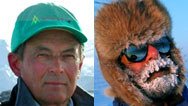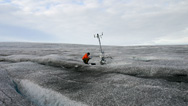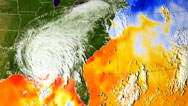Fastest Glacier
- Posted 07.26.05
- NOVA scienceNOW
Greenland's Jakobshavn glacier dumps more water into the ocean in a day than New York City uses in one month, and that rate is double what it was merely a decade ago. Why the speed-up? NOVA scienceNOW correspondent Peter Standring accompanies scientists as they explore the complex dynamics of this massive glacier and try to unravel the mystery of its hurried melting.
Transcript
FASTEST GLACIER
PBS Airdate: July 26, 2005
ROBERT KRULWICH: And now, with RNAi as their key, scientists will have the means to decode every living thing, to identify the genes that allow us to grow, that allow us to move, that give us beauty and color.
RNA is a modest little molecule, but what it gives us is the world.
So now we go from the profound to the creepy. Imagine, if you will, a glacier, one of those vast mountains of ice that hang off mountains or off coastlines. When you read about glaciers, they tell you that every year glaciers move. They don't sprint, exactly. They just creep along at a rate of, well, we did look it up, and if this block of ice right here were a typical glacier, it would move about ten inches every day.
So if I am standing, as I am right now, 20 inches from—let's make this an incoming glacier—in two days, it would move from where it is now to here.
So that's an average glacial speed. It's less than one foot every day. Now here's the puzzle. We're going to take you to a real glacier. It's a big one that, for some reason, says our correspondent, Peter Standring, is behaving very badly.
PETER STANDRING (Correspondent): Take a look around. This is Greenland's largest glacier, the Jakobshavn. It's more than four miles wide and over 1,000 feet thick. It looks solid and indestructible, but looks can be deceiving.
Like any glacier, the Jakobshavn is actually a river of ice; it's moving. Fed by the massive Greenland ice sheet, it's now the fastest moving glacier in the world.
Jay Zwally, a glaciologist from NASA, knows exactly how fast the ice is moving.
JAY ZWALLY (NASA): So right now this ice is moving. You can't feel it moving. It's moving this far in one day. In a month, it'll be five feet past that pole over there.
PETER STANDRING: Instead of moving one foot a day, which is normal for glaciers, in the last five years the speed of the Jakobshavn has increased to an astounding 113 feet every day, and no one knows why. It's a mystery buried deep within the arctic ice.
Here, you can see the consequence of all that speeding up, where the glacier meets the sea and enormous icebergs break off. This glacier is not just speeding up; it's shrinking, eight miles in just the last five years, as huge pieces of ice fall into the ocean.
To give you a better idea of just how much ice, take a look at this iceberg here. We're estimating it to be about 50 feet high. In terms of thickness, that's how much ice the Jakobshavn Glacier is losing each year. The result is that this glacier alone is responsible for four percent of all sea level rise worldwide. So why is this happening?
At this research station set up on the Greenland ice sheet, scientists use a variety of tools to answer that question.
Hello, there. How are we doing? Are we keeping warm?
KONRAD STEFFEN (University of Colorado): Yes.
PETER STANDRING: Konrad Steffen is the camp's founder. He's spent the last 31 winters out on the Arctic ice.
And do you guys manage to go about your business and your experiments without freezing to death out here?
KONRAD STEFFEN: Oh, I have never lost a grad student here on the ice.
PETER STANDRING: About 10 miles from camp is this GPS receiver, which gives precise measurements of the position of the ice. This allows scientists to track changes in its speed and when they happen.
JAY ZWALLY: It's always exciting to take a look and turn the unit on and see what it's recorded throughout the year.
PETER STANDRING: Around the clock, weather stations measure the height of the snow pack, the wind speed, humidity and temperature. These instruments collect volumes of information, and here is where they put it all together. These red tents serve as both kitchen and laboratory.
KONRAD STEFFEN: Good morning.
MAN: Good morning.
KONRAD STEFFEN: I heard you have Starbucks here.
PETER STANDRING: A warm place to ponder the mystery of what's happening to the Jakobshavn Glacier.
KONRAD STEFFEN: That's minus 5.8.
PETER STANDRING: And is that Fahrenheit or Celsius?
KONRAD STEFFEN: That's all in Celsius. We measure everything in Celsius.
PETER STANDRING: Koni Steffen says that the main culprit is rising temperatures.
KONRAD STEFFEN: The summer temperature have increased by about one and a half to two degrees over the 15 years, but the winter temperature have increased by six degrees.
PETER STANDRING: That temperature increase has led to a longer melt period, more days each year when the ice melts rather than freezes.
Aerial and satellite observations show that the melt water, that blue area on the ice, doesn't stay on surface. So where does it go?
I know it's hard to imagine, but I'm actually standing at the bottom of a big lake. It measures three miles by three miles. By the end of July, enough of this ice and snow will have melted to fill this lake with 60 feet of water. Eventually, all of that water finds a hole and makes its way down to the bottom of the ice sheet.
Glaciologists thought that water would freeze before it ever made its way down through 4,000 feet of ice. And normally it would, if it weren't for one thing. The incredible pressure caused by the huge volume of increased melt water on the surface forces it to the bottom by sheer weight.
JAY ZWALLY: What people didn't know before was where that water went. They thought maybe it stayed in the glacier, thought maybe it went to the bottom, stayed in a tunnel. But our results show that it goes to the bottom and spreads out, actually lifts the glacier up a little bit, and allows it to flow partly on a bed of water.
PETER STANDRING: Literally sliding it into the sea. And although this effect takes place mostly in the summer, recent satellite measurements show that even in the sub-zero Arctic winter, when there is no melt effect, the Jakobshavn is showing little signs of slowing down. Jay Zwally places the blame for this on global warming.
JAY ZWALLY: The really disturbing thing is the pace of things that have been happening in the last 10 years. And almost all of the scientists in the world, all the respectable scientists, believe that man is having a definite impact. And we're seeing this more in the Arctic than anywhere else.
PETER STANDRING: Just as unsettling is data from some of Greenland's other glaciers that show that they, too, are starting to undergo the same dramatic changes. Where and when or even if this will stop, no one knows.
But what scientists do know is that changes they once thought occurred over hundreds or thousands of years are today taking place right in front of their eyes.
Credits
Fastest Glacier
- Edited by
- David Small & Stephen Mack
- Produced and Directed by
- Peter Doyle
NOVA scienceNOW
- Executive Producer
- Samuel Fine
- Executive Editor
- Robert Krulwich
- Senior Series Producer
- Vincent Liota
- Supervising Producer
- Andrea Cross
- Development Producer
- Kyla Dunn
- Associate Producer
- Win Rosenfeld
- Program Editor
- David Small
- Unit Manager
- Candace White
- Senior Researcher
- Jason Spingarn-Koff
- Production Secretary
- Hong Jung
- Music
- Rob Morsberger
- NOVA scienceNOW Series Animation
- Edgeworx
- Associate Producers
- Marty Johnson
Anthony Manupelli
Mary Robertson - Compositing
- Yunsik Noh
- Camera
- Edgar Boyles
Joel Coblenz
Brian Dowley
Anthony Forma
Mark Gunning - Sound Recordists
- Ted Gesing
Mike Karas
David Pickner
Erik Reisner
Merce Williams - Aerial Production Coordinator
- Billy Richards
- Audio Mix
- John Jenkins
- Animation
- Mitch Butler
Sputnik - Production Assistant
- Robbie Gemmel
- Interns
- Maxwell Foxman
Jonathan Lung - Special Thanks
- Robin Abbott
Waleed Abdalati
California Fuel Cell Partnership
Ted Driscoll
Maria Ghirardi
The Metropolitan Museum of Art
National Renewable Energy Laboratory
Polytechnic University
Simon Stephenson
United Technologies Company
Brian Von Herzen - Howard Hughes Medical Institute Investigator
- Gregory Hannon, Cold Spring Harbor Laboratory
- Archival Material
- ABCNEWS VideoSource
Avalanche, Inc.
BBC Motion Gallery
Corbis Corporation
Getty Images
Photoresearchers - NOVA Series Graphics
- yU + co.
- NOVA Theme Music
- Walter Werzowa
John Luker
Musikvergnuegen, Inc. - Additional NOVA Theme Music
- Ray Loring
- Post Production Online Editor
- Spencer Gentry
- Closed Captioning
- The Caption Center
- NOVA Administrator
- Dara Bourne
- Publicity
- Adina Barnett
Lisa Cerqueira
Jonathan Renes
Diane Buxton
Olivia Wong - Senior Researcher
- Barbara Moran
- Production Coordinator
- Linda Callahan
- Unit Manager
- Lola Norman-Salako
- Paralegal
- Richard Parr
- Legal Counsel
- Susan Rosen Shishko
- Post Production Assistant
- Alex Kreuter
- Associate Producers, Post Production
- Nathan Gunner
Patrick Carey - Post Production Supervisor
- Regina O'Toole
- Post Production Editor
- Rebecca Nieto
- Post Production Manager
- Maureen Barden Lynch
- Supervising Producer
- Stephen Sweigart
- Producer, Special Projects
- Susanne Simpson
- Coordinating Producer
- Laurie Cahalane
- Senior Science Editor
- Evan Hadingham
- Senior Series Producer
- Melanie Wallace
- Managing Director
- Alan Ritsko
- Senior Executive Producer
- Paula S. Apsell
NOVA scienceNOW is a trademark of the WGBH Educational Foundation
This material is based upon work supported by the National Science Foundation under Grant No. 0229297. Any opinions, findings, and conclusions or recommendations expressed in this material are those of the author(s) and do not necessarily reflect the views of the National Science Foundation.
© 2005 WGBH Educational Foundation
All rights reserved
- Image credit: (glacier) © WGBH/NOVA, courtesy Peter Standring
Participants
- Peter Standring
- Correspondent
- Konrad Steffen
- University of Colorado Boulder
- Jay Zwally
- Glaciologist, Goddard Space Flight Center
Related Links
-

Fastest Glacier: Expert Q&A
Glaciologists Jay Zwally and Koni Steffen answer questions about the Jakobshavn glacier and glaciers in general.
-

A Tale of Fire and Ice
Two teams of scientists race to decipher a mystery that could link distant wildfires with Greenland's melting ice sheet.
-

Stronger Hurricanes
Is global warming making hurricanes more intense?
-

Hotter Oceans, Fiercer Storms
In this audio slide show, examine the link between rising sea surface temperature and more intense storms.
-

Profile: Adrienne Block
Adrienne Block studies global warming in Antarctica. She can also play "Bohemian Rhapsody" on her bassoon.
-

Fastest Glacier
See scientists in Greenland explain how a glacier there is shrinking and moving faster due to increased melting.



